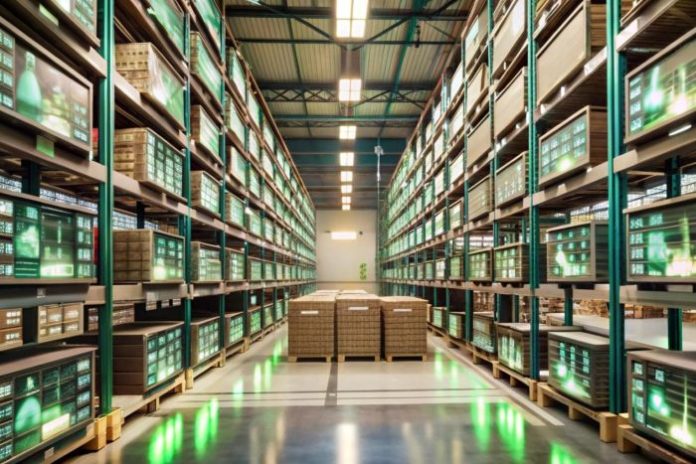Australian businesses operate in a more challenging environment. The runaway expansion of e-commerce, together with increased customer expectations for fast delivery, has placed a heavier burden than ever on warehouses, distribution centers, and production facilities. Space is becoming premium real estate, and every square meter must work harder than ever, technology, such as smart shelving and automated storage solutions, is helping businesses optimize space, streamline operations, and improve efficiency.
The solution that is being viewed nationwide is not buying more storage or more staff—it’s clever working. Groundbreaking operations managers are discovering that synergizing digital technology and physical capital yields transformational results. By marrying inventory management systems, sensors, and automation technologies with well-designed industrial and warehouse shelving, Australian businesses are designing workplaces that are not only more efficient but also safer and better adapted to future growth.
This blending of technology and storage design physicality is a paradigm shift in warehouse operation. It’s turning warehouse workers from manual inventory clerks to information-driven decision makers, and turning hotbeds of chaotic storage into precision-stoked venues for operation.
Table of contents
The Challenge: Space and Workflow Bottlenecks
Straddle dozens of Australian warehouses and you’ll spot the same challenges everywhere: jammed aisles, forklifts and employees competing for space, and stock that disappears not through theft but because it’s misplaced or blocked. Manual inventory systems mean hours of clipboard-counting, often with frustrating discrepancies between computer and manual records. Leveraging technology like digital inventory management and warehouse automation provides real-time visibility, reduces errors, and keeps operations running smoothly.
These inefficiencies come at a high cost. Slow pick rates, delayed order fulfillment, and missed shipment deadlines hurt customer trust and brand reputation. Safety incidents increase when aisles are blocked and shelving is overloaded. Smart storage solutions, including adjustable shelving and optimized layouts, make every square meter count, improving workflow, efficiency, and safety across the warehouse.
For margin-compressed Australian companies, these workflow bottlenecks directly impact the bottom line. A Western Sydney logistics company might waste valuable hours daily on inefficient inventory pulls. A Melbourne manufacturer might be plagued with production delays when parts cannot be located quickly. Regional distribution centers struggle with seasonally skewed spikes that overwhelm their congested storage facilities.
The actual issue isn’t one of capacity for storage sometimes it’s more one of how that capacity is employed and managed. Traditional approaches that merely rely on physical arrangement without digital control create systems that break down as complexity increases. The solution is to revolutionize the interface between physical infrastructure and information technology.
The Emergence of Intelligent Shelving and Cyber Storage Solutions
Smart shelving is an upgrade over traditional storage racks. Rather than being simply passive storage receptacles for inventory, they become active participants in warehouse management via built-in technology. At their core, smart shelving solutions possess firm physical infrastructure complemented by digital sensors, RFID readers, weight measurement devices, and connectivity to feed central management systems with real-time information.
Technology Layers Behind Smart Shelving
Integration is done through a number of layers of technology. Barcode scanning remains the basis, allowing fast identification and tracking as the goods move through the warehouse. RFID tags build on this by enabling bulk scanning and automatic detection as tagged products move through defined zones. Weight sensors built into shelving can detect when the quantities of goods change, triggering automatic reorder signals or reporting discrepancies that could indicate errors or shrinkage.
Inventory management tools bring these in-store touch points together into an integrated digital ecosystem. If a worker takes a product off a shelf sensor-enabled, the system automatically updates inventory levels on all platforms from the warehouse management dashboard to the e-commerce platform to the accounting system. With this real-time visibility, the historical time lag between in-store stock activity and updates to records is eliminated.
Its benefits extend far beyond simple tracking. Space utilization is significantly increased when systems are able to monitor which items are traveling fastest and provide recommendations on where to position them on the shelves. Picker errors decrease when workers receive electronic directions that take them directly to shelf locations, usually via wearable devices or hand-held units. Safety is increased through load monitoring gear that warns supervisors when shelving is approaching capacity levels, thus preventing dangerous overloading situations.
Australian companies are discovering that intelligent shelving investments pay dividends within short timeframes in terms of lower labour costs, lower error rates, and enhanced throughput. The technology is not driven by high levels of technical proficiency to run—new systems have user-friendly interfaces conducive to warehouse settings where employees are not necessarily IT-trained.
Combining Storage Management Software with Physical Smart Shelving
True power of modern warehouse operations is achieved when sophisticated software platforms are married with well-planned physical configurations. Warehouse Management Systems (WMS) and Enterprise Resource Planning (ERP) systems now also include strong spatial analysis features that allow business to better plan and utilize their industrial and warehouse shelving.
Computer mapping software allows managers to create virtual replicas of their actual warehouse space. They map shelf locations, aisle dimensions, ceiling heights, and equipment locations and use algorithms to suggest best configurations based on velocity, size, weight, and frequency of picking. Fast-moving items are placed in convenient locations, and slower-moving items occupy more distant locations.
Weight distribution becomes a science rather than a guesswork. It can be computed by software to spread weights between shelving units to achieve safety compliance while maximizing capacity. With changing inventory levels during the day, the system maintains track of current loads and can signal situations that require attention before they become hazardous.
Optimizing Warehouse Layouts Through Software
Consider a logistics company operating a distribution warehouse in Brisbane’s industrial zones. By using WMS software integrated into their shelving layout, they overhauled their picking process. The software analyzes order streams and pre-positions highly grouped products near one another. When receiving orders, the software generates optimized picking routes that achieve the shortest travel distance in the warehouse. Employees with handheld scanners execute these routes, reducing retrieval time by half while sacrificing no accuracy.
A factory in regional Victoria utilizes the same integration differently. Their ERP system monitors component usage on the production floor and automatically triggers restocking alerting. Warehouse staff are notified on their gadget when specific shelf points are low, preventing downtime before it is unavoidable. The system looks at usage patterns over time and regulates alert timing to account for seasonal variations and production schedule changes.
These combined methods work for any size business. Cloud solutions have leveled the playing field for the utilization of enterprise-grade warehouse management software, enabling small businesses that once relied on spreadsheets and manual processes to also use them.
The Role of IoT, Automation, and AI
The Internet of Things is transforming warehouses into smart, networked environments where physical goods communicate with digital systems seamlessly. Sensors embedded throughout storage areas monitor environmental conditions, movement, equipment location, and operational information all the time. The steady stream of data powers analytics platforms that detect trends and opportunities that human observers miss.
Automated Guided Vehicles (AGVs) and collaborative robots work alongside human staff, taking repeat transport tasks between storage areas and pack stations. These systems integrate with shelving configurations, using computer maps to navigate in an organized and safe way. Some advanced applications involve shelving units with automatic mobility and the capability to reorganize itself in accordance with current inventory demands—although technologies of this sort remain fairly rare within the Australian market.
Artificial intelligence-based predictive analytics segment past data into more precise predictions of future demand. The systems recognize seasonal patterns, observe trends in product demand, and can predict potential stockouts ahead of time. They take lead times, supplier history, and even external factors like weather patterns or economic metrics into account to suggest ideal levels of inventory and shelf space.
Maintenance becomes proactive rather than reactive. Sensors monitor the well-being of shelving systems, warning of indications of stress that could cause failure. Forklifts and conveyor systems indicate their status, allowing maintenance staff to fix issues during planned downtime rather than suffering from unexpected failures at critical moments.
The efficiency gains also extend to benefits for sustainability. Better visibility into inventory helps to reduce waste due to outdated or expired stock. Streamlined layouts cut the energy demand for lighting, climate control, and material handling equipment. Better forecasting means fewer rush shipments and transportation emissions.
Case Scenarios and Australian Context
Across Melbourne’s industrial suburbs, warehouses serving the booming e-commerce sector are adopting modular shelving systems with rapid reconfiguration capacity. One of the third-party logistics providers fitted adjustable industrial and warehouse shelving that can be rearranged as the needs of their clients change. Coupled with cloud-based inventory management software accessible to all of their clients, they’ve become an adaptable fulfillment partner with capacity for multiple types of product and changing volumes of orders.
In western Sydney, a building materials distributor was finding it hard to manage thousands of SKUs in different weights and sizes. They have invested in heavy-duty smart shelving with weight sensors integrated and a WMS that automatically optimizes picking routes based on order fragility and weight. The system intelligently groups orders so that they won’t be damaged by heavier products during the picking process. Productivity among employees improved a great deal because they spent less time on route planning and more time filling orders.
Regional businesses are finding that technology brings the playing field into even. A regional Queensland drug distributor implemented barcode tracking and temperature-sensing sensors with their cold storage shelving. In no way hindered by their rural location, they have the same degree of inventory accuracy and regulatory compliance as the big metropolitan operations. Cloud connectivity makes sure their systems receive the same real-time updates and security patches as any enterprise warehouse.
Small manufacturing companies with limited budgets are starting with minimal improvements—trading cramped storage space for structured shelving, adding simple barcode scanning, and implementing low-cost cloud-based software to track inventory movement. These small improvements pay back in short order while providing the foundation for higher-tech tools as the company grows.
The Future of Warehouse Efficiency
The direction of warehouse technology is towards tighter, more integrated coupling between physical and virtual worlds. Robotics will become more universal and cost-effective, with collaborative robots co-existing with human workers in safety rather than replacing them. The systems will require specialized shelving for robotic applications—custom heights, widths, and material properties to allow machines to speak to one another.
Digital twin technology will enable managers to simulate changes before implementing them in the real world. Want to know how reconfiguring your shelving arrangement will affect picking efficiency? Use actual operational data to simulate alternate scenarios and try different scenarios virtually before even moving one shelf. This reduces disruption and increases confidence in strategic moves.
Augmented reality applications will guide warehouse staff through complex processes, overlaying virtual information on their actual view of the warehouse. AR glasses-wearing staff can maybe see highlighted paths to specific products, load warning overlays on shelves, or assembly instructions for complex orders step by step.
Sustainability will drive innovation in shelving materials and design. Increased utilization of recycled steel, modular systems designed for decades, not years, and material-reducing designs without loss of structural integrity will be the norm. Energy harvesting technology would enable sensors to be powered by kinetic energy from moving stock or ambient light, thus bypassing wired power infrastructure.
Those warehouse operations that will be most successful will be the most flexible. Technology evolves rapidly, and systems must be capable of receiving upgrades without requiring complete overhauls. Modular shelving, open-standards for communications protocols, and cloud-based software platforms provide the flexibility required to accommodate innovations as they emerge.
Conclusion
The union of digital technology with well-engineered physical infrastructure is revolutionizing how Australian businesses organize warehouse operations. By skillfully integrating inventory management systems, IoT sensors, and automation software with heavy-duty [industrial and warehouse shelving, organizations build facilities where efficiency, safety, and scalability all progress in harmony.
The path to improvement begins with honest assessment. Walk through your warehouse with fresh eyes—where are the pinch points? What processes require disproportionate amounts of time? What safety concerns keep you up at night? Then, address improvement that aims to solve your most pressing problems, whether that’s implementing easy inventory software, redesigning your shelving layout for better flow, or implementing smart shelving technology.
Remember, however, that change need not be a large up-front investment. Start with the basics like smart shelving, prove their value, then build on achievement. The most sophisticated Sydney warehouse began with simple systematic ordering and built upon it. Your journey to smarter, technology-enabled operations begins with that first step—and the potential reward in the form of efficiency, safety, and competitive advantage makes it a journey well traveled.











